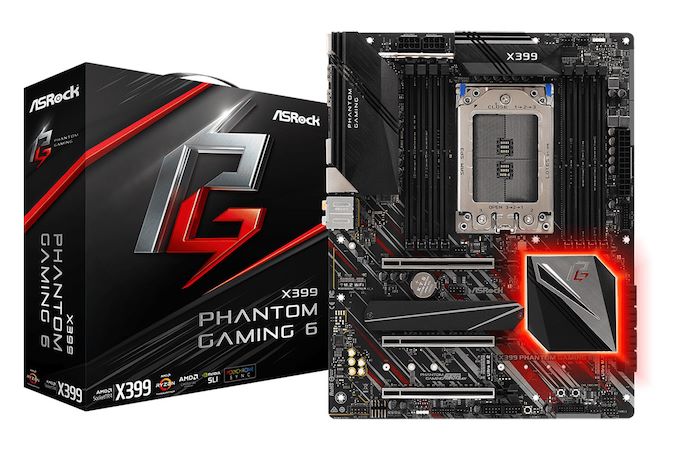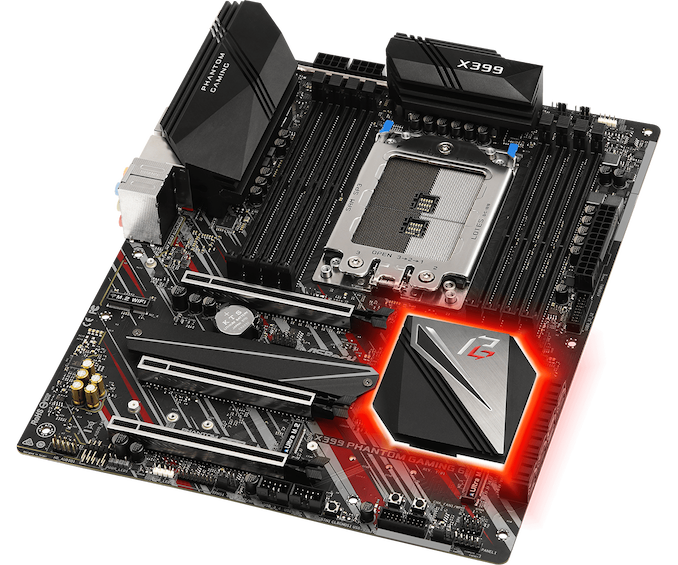The ASRock X399 Phantom Gaming 6 Motherboard Review: $250 Sixteen Core Stunner
by Gavin Bonshor on March 12, 2019 10:00 AM EST- Posted in
- Motherboards
- AMD
- ASRock
- ATX
- ThreadRipper
- X399
- TR4
- 2950X
- 2.5G
- Phantom Gaming 6
ASRock X399 Phantom Gaming 6 Conclusion
The ASRock X399 Phantom Gaming 6 is an ATX sized offering with the aims to dominate the entry-level segment of Threadripper motherboards. It has an MSRP of $250, which puts it $30 cheaper than the GIGABYTE X399 Aorus Pro ($280) and $70 lower than the ASRock X399 Taichi ($350). On paper, the ASRock X399 Phantom Gaming 6 offers more in terms of feature set than the GIGABYTE X399 Aorus Pro.
ASRock also enabled this motherboard with a few unique features, such as 2.5 gigabit ethernet, and expanded on common features, like triple M.2 for storage and triple x16 for add-in graphics. Its biggest caveat is in the CPU support list, with the ASRock X399 Phantom Gaming 6 offering support for Threadripper processors with a TDP up to 180 W. The power delivery is actually quite good for the 180W CPUs, running in a 6+2 configuration which is spearheaded by an Intersil ISL69147 7-phase PWM controller and six Intersil ISL99227 power stages that have direct mental contacts with a large 60 A rating. This kind of setup is fine for 180 W processors under optimal thermal conditions, but it’s not extensive enough for 250 W and the decision to limit it to 180 W is a good call. That gives the ASRock X399 Phantom Gaming 6 a unique position against the other competitors in that more useful and premium features can be added for users who opt for CPUs such as the Threadripper 2950X.
Performance in our test suite and in overclocking the Ryzen Threadripper 2950X processor proved competitive and shows that the X399 Phantom Gaming 6 is no slouch. The biggest win for the Phantom Gaming branded model was in DPC latency with a better than average score than the rest of the pack previously tested. Our CPU performance and gaming performance results we’re consistent with what was expected. The only real negative came in POST time with the second worst result on the X399 platform. We managed to achieve an overclock of 4.2 GHz with 1.425 V on the CPU Vcore and didn’t experience too much in the way of VDroop; it undervolted our CPU by just under 0.02 V. This is acceptable and didn’t cause any issues regarding the stability of the overclock.
Calling a $250 Threadripper compatible motherboard ‘budget’ is a bit of a stretch, but ASRock has a highly competitive and well-positioned model in the X399 Phantom Gaming 6. The design is modern and neutral and users looking for RGB will appreciate the two RGB headers and single addressable RGB header; the ASRock Polychrome Sync RGB software is one of the best utilities on the market as far as motherboards go. For users looking for a cheaper and feature-rich foundation for Threadripper based system and like gaming features such as 2.5 GbE NIC, the ASRock X399 Phantom Gaming 6 adds to a small X399 selection, but with something very appealing and offers good value. Workstation users looking to build a Threadripper 2990WX based system aren’t likely to grumble at $100 more for a beefier motherboard, and ASRock’s decision to limit CPU power to 180 W isn’t a detriment, but actually focuses cost where it needs to. At the price point, the ASRock X399 Phantom Gaming 6 is a serious board for the Threadripper entry level market and is certainly one to be considered.
Other AnandTech Ryzen Threadripper Coverage
- The ASRock X399 Taichi Motherboard Review: Cost-Effective Threadripper
- The MSI MEG X399 Creation Motherboard Review: The New 16-Phase Shark In Town
- The ASUS X399 ROG Zenith Extreme Motherboard Review: Top Tier Threadripper
- GIGABYTE's X399 Aorus Extreme: The Threadripper 2 Halo Motherboard
- The ASRock X399 Professional Gaming Motherboard Review: 10G For All
- The GIGABYTE X399 DESIGNARE EX Motherboard Review












22 Comments
View All Comments
andychow - Tuesday, March 12, 2019 - link
These days, pcbs come with anywhere from 1 to 14 layers. I'm assuming that this means the audio circuits are isolated on their own layers.sonny73n - Tuesday, March 12, 2019 - link
Then it should be stated as "The audio PCB is on its own layer”. But I’ll have to break it down to see it for myself.Alexvrb - Tuesday, March 12, 2019 - link
"ASRock has built this motherboard to support AMD Threadripper with a thermal design point of up to 180 W, which means it can only support up to 16 core processors such as the AMD Threadripper 2950X."Zen 2 will pack more cores in that same envelope. I find it highly likely even an entry-level TR4 board like this will support more cores when the next-gen models hit the market - after a BIOS update, of course.
Smell This - Tuesday, March 12, 2019 - link
El-Oh-El @ 'post latency'Want some whine with that cheese, much?
sorten - Tuesday, March 12, 2019 - link
Weird product offering, considering Threadripper isn't a gaming CPU.TrackSmart - Wednesday, March 13, 2019 - link
Agreed regarding Threadripper and gaming-centric builds. It doesn't make a lot of sense.Of course, to look at the marketing used on computer components, one would clearly come to the conclusion that *almost all* powerful computers are primarily designed for gaming!
Now, please explain to the finance department why we appear to be purchasing "gaming" equipment for our high-end workstations...
xray9 - Wednesday, March 13, 2019 - link
I am wondering why thunderbolt is still not available with AMD boards. AFAIR Intel ceased license fees for this technology. Even for Intel boards this option is rare, especially if you want to build a Xeon based system to get ECC RAM as well. Do you know why this is the case ?AMD would be interesting as platform supporting ECC RAM compared to Intel Xeon, because the AMD CPU offering look good and are cheaper compared to Xeon.
One proposal for mainboard reviews. Could you kindly perform DPC latency measuring with LatencyMon in your reviews ? One time with default BIOS settings and one time with energy saving disabled ?
It would be very useful for people to identify good designed mainboards to achieve a very responsive systems for i.e. recording or gaming.
I had for example in the past a bogus mainboard where kernel timer latency was relatively high which caused audio drops. The only way was to use higher ASIO buffer sizes for recording, which is in some situations not so ideal.
I replaced the mainboard with the successor of this board on the same system.
And of all sudden the kernel timer latency went down to the absolute minimum of ~2 microseconds on an IDLE system, which was never possible with the other mainboard.
On some Laptop Reviews I saw in the past that they deliver these figures, which I regard as very useful. The lower kernel latency is, the quicker CPU cores are available for working on processes and threads without lag.
Valantar - Wednesday, March 13, 2019 - link
I wish this board was around back when I built my partner's TR workstation in late 2017. We went for the Asus X399-E Strix, and frankly I think I would have preferred this. More m.2 (the Strix has one + one on a kinda awkward bracket), standard ATX size, and very noticeably cheaper. The BYO WiFi solution is good IMO - m.2 WiFi cards are dirt cheap, you can pick whatever rocks your boat, or leave it if you don't care. I just wish the WiFi bracket was instead integrated into the I/O plate - there's room in the middle there. Other than that: Good job ASRock.Valantar - Wednesday, March 13, 2019 - link
... and I entirely forgot to mention the 2.5Gbit Ethernet. That's a _huge_ plus (if only someone were to launch some cheap-ish 5p 2.5/5GbE switches!)guyr - Saturday, April 6, 2019 - link
I'm a software developer, and this board looks great for that application. I want cores, high clocks and fast storage; I specifically don't care about multiple GPUs, so the 4x16 configuration of most of the existing Threadripper motherboards was overkill. This board appears to have what I actually need, saving cost on features I don't: 8 DIMMs for plenty of memory, 3 M.2 for fast storage, and of course the Threadripper. 16 cores is fine for software development, though perhaps with Zen 3 we'll get 32 cores in the 180 watt envelop. Kudos to ASRock for diversifying the market.